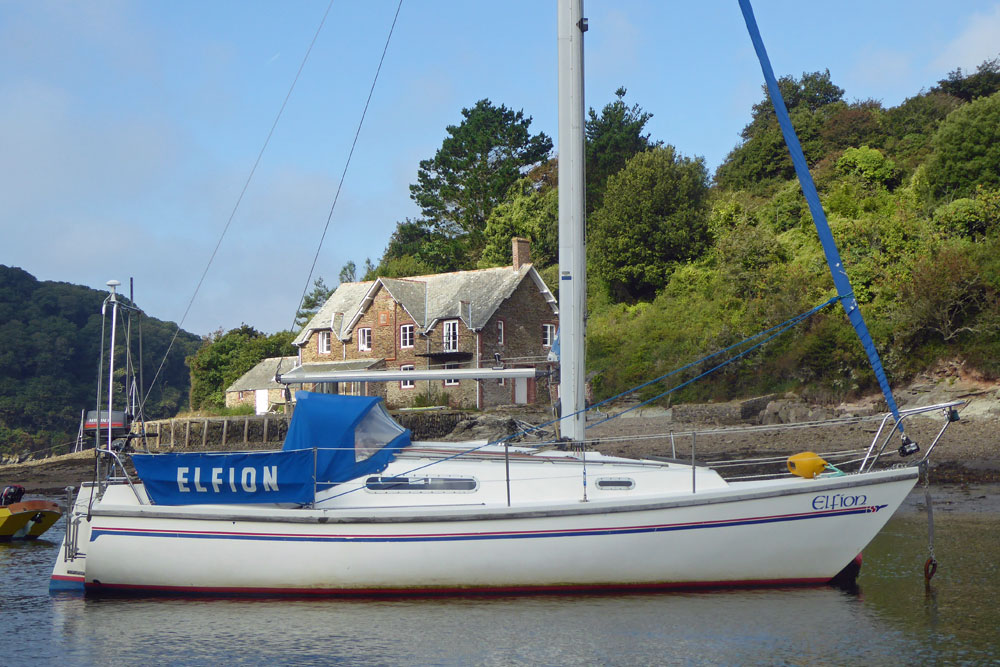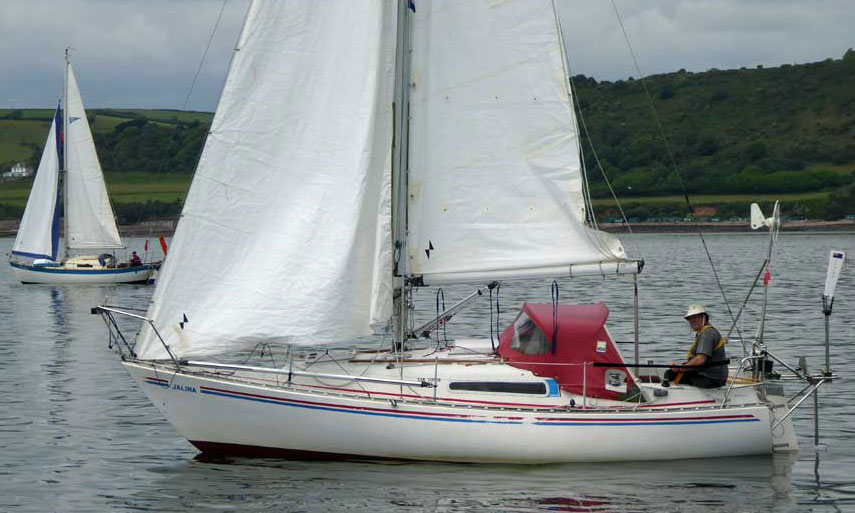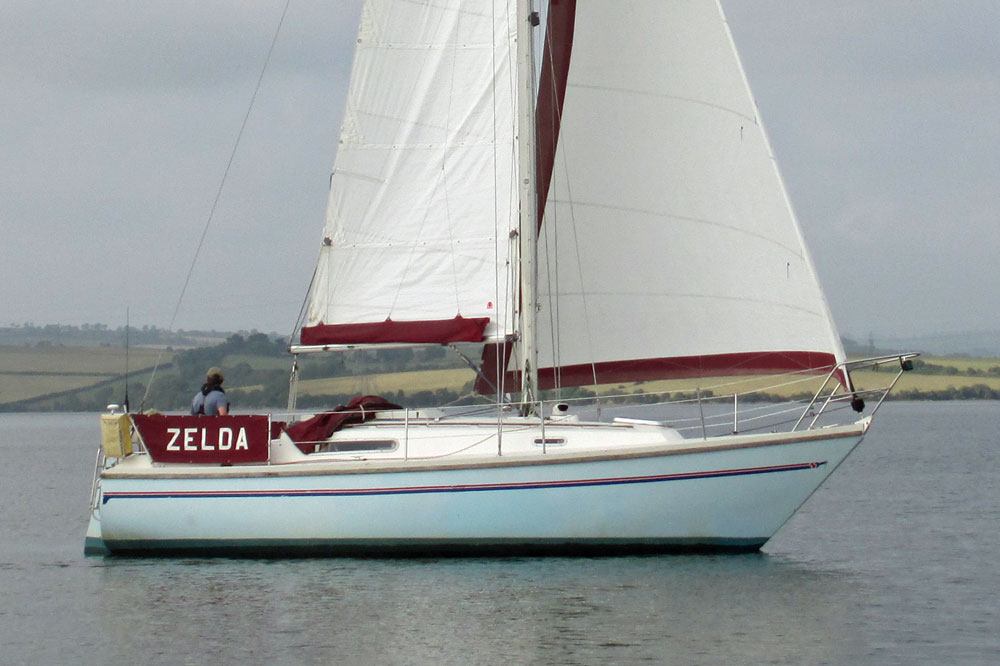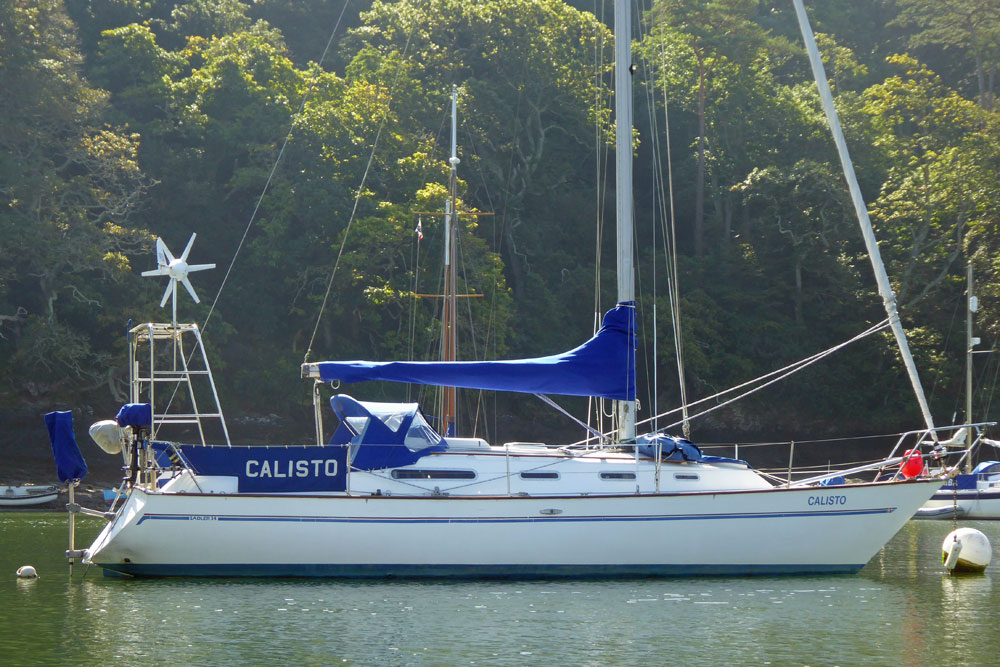- Home
- Cruiser Yachts under 30'
- Sadler 26
The Sadler 26 Sailboat
Specs & Key Performance Indicators
The Sadler 26 is a small but sturdy sailboat that was designed by David Sadler and built by Sadler Yachts. It is a descendant of the famous Contessa 26 and the Sadler 25, and it inherits some of their best features, such as a sea-kindly hull, a well-balanced rig, and a foam-filled double skin that makes it virtually unsinkable.
The Sadler 26 is a versatile boat that can accommodate up to six people for coastal cruising, or take on longer voyages with a smaller crew. It has proven its ability to handle rough weather and challenging conditions, as well as to perform well in races and rallies.
Published Specification for the Sadler 26
Underwater Profile: Fin keel with transom-hung rudder
Hull Material: GRP (Fibreglass)
Length Overall: 25'9" (7.9m)
Waterline Length: 20'6" (6.3m)
Beam: 9'5" (2.9m)
Draft: 4'8" (1.4m)
Rig Type: Masthead sloop
Displacement: 4,800 lb (2,177 kg)
Designer: David Sadler
Builder: Sadler Yachts (UK)
Year First Built: 1981
Published Design Ratios for the Sadler 26
1. Sail Area/Displacement Ratio: 16.3
2. Ballast/Displacement Ratio: 40.7
3. Displacement/Length Ratio: 237
4. Comfort Ratio: 20.8
5. Capsize Screening Formula: 2.0
The Sadler 26: A Few FAQs...
Based on the published Design Ratios for the Sadler 26, how would you expect the boat to perform under sail?
Based on the published Design Ratios for the Sadler 26, how would you expect the boat to perform under sail?
The Design Ratios indicate that the Sadler 26 is a moderate weight sailboat that is slightly underpowered, but very stable and stiff. It has a low risk of capsize and a moderate level of comfort for offshore sailing. It is best suited for light to moderate wind conditions, and it can sail close to the wind with good pointing ability. It may need to reef early in strong winds, and it may not be very fast or responsive in light airs.
Is the Sadler 26 still in production and, if not, when did production end and how many of these sailboats were built?
Is the Sadler 26 still in production and, if not, when did production end and how many of these sailboats were built?
The Sadler 26 is no longer in production. Production ended in 1991, after about 200 boats were built.
What, if any, alternative versions of the Sadler 26 were built and what are the differences between them?
What, if any, alternative versions of the Sadler 26 were built and what are the differences between them?
The Sadler 26 was available with three keel options: fin, twin, or shallow fin. The fin keel version has a draft of 1.37 m (4.5 ft), the twin keel version has a draft of 1.07 m (3.5 ft), and the shallow fin version has a draft of 1.22 m (4 ft). The fin keel version is slightly faster and more agile than the other versions, but the twin keel version has better stability and shoal draft capabilities. The shallow fin version is a compromise between the two.
The Sadler 26 was also available with two rig options: masthead sloop or fractional sloop. The masthead sloop has a taller mast and a larger genoa than the fractional sloop, which has a shorter mast and a larger mainsail. The masthead sloop has more sail area and more power in light winds, but the fractional sloop has more balance and control in strong winds.
How many people can sleep on board a Sadler 26?
How many people can sleep on board a Sadler 26?
The Sadler 26 can sleep up to six people in three cabins: a V-berth in the forepeak, a double berth in the saloon (converted from the dinette), and a quarter berth aft on the starboard side. However, for longer trips or more comfort, four people would be more realistic.
How did the sailing press review the Sadler 26?
How did the sailing press review the Sadler 26?
The sailing press generally gave positive reviews to the Sadler 26, praising its seaworthiness, safety, practicality, and performance.
For example, Yachting Monthly described it as "the ultimate small yacht or just an overgrown dinghy" and "a proper yacht, with a high ballast ratio for stiffness and upwind power".
Practical Boat Owner called it "a very capable little cruiser" and "a boat that will look after you".
Sailing Today said it was "a great little boat that will take you anywhere".
What is the history of the builders of the Sadler 26 and is the company still in business?
What is the history of the builders of the Sadler 26 and is the company still in business?
The Sadler 26 was built by Sadler Yachts, a family-run company founded by David Sadler in 1974. David Sadler was a naval architect and yacht designer who had previously worked for Jeremy Rogers, the builder of the Contessa 26 and 32. David Sadler designed the Sadler 25, 26, 29, 32, and 34, as well as the Starlight 35 and 39. His son, Martin Sadler, joined the company in 1979 and took over as managing director in 1986. He designed the Sadler Barracuda and the Starlight 46.
Sadler Yachts ceased trading in 2008, after being hit by the financial crisis and a fire that destroyed their factory in Poole. The company was acquired by Vector Works Marine Ltd, which continued to produce the Starlight range and offer spares and services for existing Sadler owners. However, Vector Works Marine Ltd also went into administration in 2012. The Sadler and Starlight brands are now owned by Discovery Yachts Group, which offers brokerage, refit, and repair services for these boats.
What is the average cost of a secondhand Sadler 26?
What is the average cost of a secondhand Sadler 26?
The average cost of a secondhand Sadler 26 depends on several factors, such as the year of manufacture, the condition of the boat, the equipment and accessories included, and the location of the boat. According to some online sources, the price range of a secondhand Sadler 26 can vary from £7,000 to £18,000.
What other sailboats have been created by the designer of the Sadler 26?
What other sailboats have been created by the designer of the Sadler 26?
The designer of the Sadler 26 is David Sadler, a naval architect and yacht designer who has created several other sailboats, such as:
- The Contessa 26, a classic and elegant sailboat that was designed in 1965 and built by Jeremy Rogers. It is famous for its seaworthiness and beauty, and for being the boat that Tania Aebi sailed around the world solo at the age of 18.
- The Sadler 25, a predecessor of the Sadler 26 was designed in 1974 and built by Sadler Yachts. It is similar to the Contessa 26, but with more beam, headroom, and freeboard. It has a single-skin hull and a fin or twin keel option.
- The Sadler 29, a successor of the Sadler 26 that was designed in 1981 and built by Sadler Yachts. It is larger and more spacious than the Sadler 26, but with the same foam-filled double skin construction. It has a fin or bilge keel option.
- The Sadler 32, a larger version of the Sadler 29 that was designed in 1979 and built by Sadler Yachts. It is a fast and seaworthy cruiser that can accommodate up to seven people. It has a fin or bilge keel option.
- The Sadler 34, a further development of the Sadler 32 that was designed in 1983 and built by Sadler Yachts. It is a comfortable and capable cruiser that can handle long passages or short hops. It has a fin or bilge keel option.
- The Starlight 35, a performance cruiser that was designed in 1990 and built by Starlight Yachts (a division of Sadler Yachts). It is a sleek and stylish boat that combines speed and comfort. It has a fin keel and a fractional rig.
- The Starlight 39, a larger version of the Starlight 35 that was designed in 1992 and built by Starlight Yachts. It is a spacious and luxurious boat that offers excellent sailing qualities. It has a fin keel and a masthead rig.
The above answers were drafted by sailboat-cruising.com using GPT-4 (OpenAI’s large-scale language-generation model) as a research assistant to develop source material; to the best of our knowledge, we believe them to be accurate.
Other sailboats in the Sadler range include:
Recent Articles
-
Passoa 47 Sailboat Review: Comprehensive Specs & Performance Analysis
Jan 04, 26 04:57 AM
Discover the Passoa 47, a legendary aluminium blue water cruiser by Garcia. Explore technical specifications, design ratios, and why its lifting keel is a game-changer for offshore sailors. -
Sailboat Wheel Steering Maintenance & Inspection Checklist
Dec 30, 25 02:32 PM
Keep your vessel’s helm responsive and reliable with our expert maintenance checklist. Master cable tensioning and system inspections to avoid mid-passage failures. -
Modern Boat Electronics and the Latest Marine Instruments
Dec 20, 25 05:27 PM
Should sailboat instruments be linked to the latest boat electronics as a fully integrated system, or is it best to leave them as independent units?
















